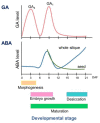Molecular Aspects of Seed Development Controlled by Gibberellins and Abscisic Acids
- PMID: 35163798
- PMCID: PMC8837179
- DOI: 10.3390/ijms23031876
Molecular Aspects of Seed Development Controlled by Gibberellins and Abscisic Acids
Abstract
Plants have evolved seeds to permit the survival and dispersion of their lineages by providing nutrition for embryo growth and resistance to unfavorable environmental conditions. Seed formation is a complicated process that can be roughly divided into embryogenesis and the maturation phase, characterized by accumulation of storage compound, acquisition of desiccation tolerance, arrest of growth, and acquisition of dormancy. Concerted regulation of several signaling pathways, including hormonal and metabolic signals and gene networks, is required to accomplish seed formation. Recent studies have identified the major network of genes and hormonal signals in seed development, mainly in maturation. Gibberellin (GA) and abscisic acids (ABA) are recognized as the main hormones that antagonistically regulate seed development and germination. Especially, knowledge of the molecular mechanism of ABA regulation of seed maturation, including regulation of dormancy, accumulation of storage compounds, and desiccation tolerance, has been accumulated. However, the function of ABA and GA during embryogenesis still remains elusive. In this review, we summarize the current understanding of the sophisticated molecular networks of genes and signaling of GA and ABA in the regulation of seed development from embryogenesis to maturation.
Keywords: abscisic acid (ABA); gibberellin (GA); seed development; seed maturation.
Conflict of interest statement
The authors declare that there is no conflict of interest.
Figures


Similar articles
-
Identification of genes involved in metabolism and signalling of abscisic acid and gibberellins during Epimedium pseudowushanense B.L.Guo seed morphophysiological dormancy.Plant Cell Rep. 2018 Jul;37(7):1061-1075. doi: 10.1007/s00299-018-2291-8. Epub 2018 May 23. Plant Cell Rep. 2018. PMID: 29796945
-
The pivotal role of abscisic acid signaling during transition from seed maturation to germination.Plant Cell Rep. 2017 May;36(5):689-703. doi: 10.1007/s00299-016-2082-z. Epub 2016 Nov 23. Plant Cell Rep. 2017. PMID: 27882409 Review.
-
AtPER1 enhances primary seed dormancy and reduces seed germination by suppressing the ABA catabolism and GA biosynthesis in Arabidopsis seeds.Plant J. 2020 Jan;101(2):310-323. doi: 10.1111/tpj.14542. Epub 2019 Oct 22. Plant J. 2020. PMID: 31536657
-
Modulation in the ratio of abscisic acid to gibberellin level determines genetic variation of seed dormancy in barley (Hordeum vulgare L.).J Plant Physiol. 2024 Oct;301:154301. doi: 10.1016/j.jplph.2024.154301. Epub 2024 Jun 28. J Plant Physiol. 2024. PMID: 38968782
-
Exploring fine tuning between phytohormones and ROS signaling cascade in regulation of seed dormancy, germination and seedling development.Plant Physiol Biochem. 2024 Feb;207:108352. doi: 10.1016/j.plaphy.2024.108352. Epub 2024 Jan 14. Plant Physiol Biochem. 2024. PMID: 38266558 Review.
Cited by
-
Overexpression of 9-cis-Epoxycarotenoid Dioxygenase Gene, IbNCED1, Negatively Regulates Plant Height in Transgenic Sweet Potato.Int J Mol Sci. 2023 Jun 21;24(13):10421. doi: 10.3390/ijms241310421. Int J Mol Sci. 2023. PMID: 37445599 Free PMC article.
-
Using Magnetic Fields to Enhance the Seed Germination, Growth, and Yield of Plants.Methods Mol Biol. 2024;2788:375-395. doi: 10.1007/978-1-0716-3782-1_22. Methods Mol Biol. 2024. PMID: 38656526
-
Transcriptome and metabolome analyses reveal regulatory networks associated with nutrition synthesis in sorghum seeds.Commun Biol. 2024 Jul 10;7(1):841. doi: 10.1038/s42003-024-06525-7. Commun Biol. 2024. PMID: 38987396 Free PMC article.
-
Evaluation of the Effect of Light Color on Albumins and Globulins Content During Bean Germination.Foods. 2025 May 14;14(10):1750. doi: 10.3390/foods14101750. Foods. 2025. PMID: 40428529 Free PMC article.
-
The tomato EAR-motif repressor, SlERF36, accelerates growth transitions and reduces plant life cycle by regulating GA levels and responses.Plant Biotechnol J. 2024 Apr;22(4):848-862. doi: 10.1111/pbi.14228. Epub 2023 Dec 21. Plant Biotechnol J. 2024. PMID: 38127946 Free PMC article.
References
Publication types
MeSH terms
Substances
LinkOut - more resources
Full Text Sources

